Content
- 1 What is cider
- 2 Flavor, color and strength of apple cider
- 3 The chemical composition and calorie content of apple cider
- 4 The health benefits of apple cider
- 5 How to make homemade apple cider
- 6 How to drink and serve apple cider
- 7 How is cider different from beer
- 8 Harm of apple cider and contraindications
- 9 Conclusion
Apple cider has appeared in the vastness of Russia relatively recently, but only beer can outshine it in popularity. However, the benefits and harms of apple cider are determined primarily by its composition. If we mean a product made in an industrial environment, then it can contain any components. While real cider is made from only apples and, accordingly, retains all their useful properties.
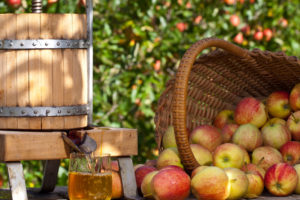
What is cider
Apple cider is a low-alcohol beverage that is produced by natural fermentation of raw apple, therefore it has many beneficial properties. In traditional recipes yeast do not use it to obtain it. Sugar is used in some cases when there is a desire to taste the drink as soon as possible or to get a carbonated product.
Flavor, color and strength of apple cider
Cider is usually characterized by a light yellow color, which, depending on the apple varieties used, can have an amber or greenish yellow hue. The natural product has a distinct apple aroma and flavor, and inexperienced consumers may even mistake it for apple juice. After all, the strength of this drink is very small. On average, it is 5-6 ° C. But it can vary depending on the recipe and manufacturing method from 1.5 to 8 ° C.
Sweet, semi-sweet or dry cider is distinguished by sugar content. It also comes in sparkling, sparkling and quiet.
The chemical composition and calorie content of apple cider
The calorie content of cider cannot be called high - depending on the sugar content in it, it can vary from 49 to 119 kcal and averages 117 kcal per 100 ml.
|
Proteins, g |
Fat, g |
Carbohydrates, g |
|
0,2 |
0,3 |
28,9 |
The chemical composition of cider and its properties are determined primarily by the composition of those apple varieties from which it is made. Most garden varieties are not suitable for making it. Here the most useful are wild or specially bred varieties that contain the maximum amount of tannins.

Tannins are plant phenols that have strong tanning properties and prevent the spread of harmful bacteria. Apples of these varieties have astringent and bitter-sour taste, they are practically unsuitable for eating. Among the garden varieties, the following varieties can be considered the closest to the ideal: Aport, Antonovka, Renet, Borovinka.
Thus, apple cider, in addition to tannins, includes vitamins C, E, B2, PP, many meso- and microelements, pectins, flavanoids. The benefits and harms of this product depend on them.
The health benefits of apple cider
The tannins that make up the cider have the properties to normalize the functioning of the gastrointestinal tract and cleanse it of harmful bacteria. The product also contains a considerable amount of pectins. And their undoubted benefit to the body lies in the fact that they:
- They absorb and remove fats and acids from the intestines.
- Gently normalizes the content of friendly microflora.
- Promote the accelerated release of radioactive substances and heavy metals.
The benefits of apple cider are also the presence of antioxidants present in these fruits and, accordingly, in the drink. They have the ability to increase the level of endorphins, which are often called "hormones of happiness." Indeed, even in ancient times, healers recommended the use of apple cider for depression. In our difficult times, the benefits of such a drink can hardly be overestimated.
In addition, some researchers argue that cider's health benefits include lowering the risk of asthma, diabetes and cancer.
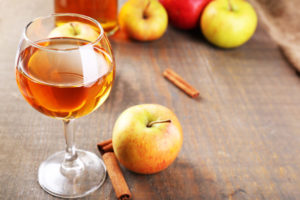
For immunity
If the cider was produced in a natural way, then it retains a significant amount of vitamin C. A, which means that its benefits in increasing immunity and resistance in the fight against various infections, especially in the cold season, are obvious.
For the cardiovascular system
It is known that small amounts of alcohol contribute to vasodilation. But the benefits of cider for the cardiovascular system are not only in the alcohol content.
Indeed, in the process of natural fermentation of apple juice, additional enzymes are formed, which strengthen the walls of blood vessels, making them elastic, and reduce the amount of cholesterol. Therefore, a small amount of cider (120 ml per day) can bring certain benefits to people with hypertension. But in everything one should observe the measure, otherwise the benefit will turn into harm. It is especially dangerous for people with chronic diseases to self-medicate - consultation with a treating specialist is necessary.
Slimming
In matters of diet, the benefits and harms of apple cider can be relevant, not only for women, but also for men. It's no secret that men like to pamper themselves with beer, from the excessive consumption of which extra pounds appear in weight.
Drinking apple cider (200 ml before dinner) is considered beneficial as an adjunct to many diets. The enzymes contained in this drink break down fats and gently adjust the metabolism.
It should only be remembered that semi-sweet and sweet cider contain a fairly decent amount of sugar, the use of which while losing weight can do more harm than good.
How to make homemade apple cider
Making apple cider with your own hands is not difficult at all, but you can be 100% confident in the beneficial properties of the product. You just need to find suitable fruits and the easiest way to do this is in abandoned gardens or even in a forest where wild apple trees grow. Not only are not any apples needed for making cider, they still need to be kept for at least 2-4 days in a warm room.
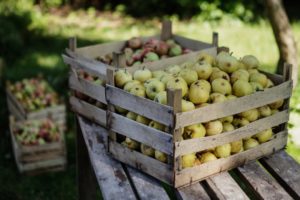
In the future, you can use two methods of making cider: from fruits with sugar and from apple juice without added sugar.
The first way
This recipe will require:
- 10 kg of apples, peeled from seeds and twigs;
- 1.5 kg of sugar.
The cooking process consists of the following steps:
- The apples are sorted out, removing all tainted spots and cutting out all the tails and seeds.
- Then they are passed through a meat grinder and supplemented with sugar, stirred thoroughly.
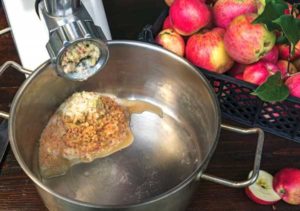
- Fill clean and dry containers with the grated apple mixture to about 2/3 of the original volume. You can use three liter cans.
- The opening of each jar is covered with gauze and placed for 3-4 days in a warm place with a temperature of + 23 ° C to + 25 ° C, without light. The contents of the jars are stirred every day.
- When the apple mass actively ferments (foam and a characteristic smell will appear), juice is squeezed out of the mass and poured in the same volume into dry cans.
- A rubber glove with a hole in one finger or a water seal is placed on each jar. This is necessary in order to limit the access of oxygen to the apple juice, otherwise it can simply turn sour.
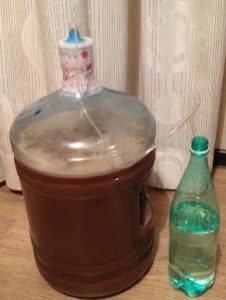
- Banks are placed in a dark and warm place for 20 to 65 days. Fermentation can be considered complete if the glove falls off and a thick sediment falls to the bottom.
- The cider is carefully drained from the cans without affecting the sediment. This can be done through a special flexible tube by lowering one end of it below the level of the can.
- It is advisable to additionally filter the drink and pour it into bottles, tightly sealing it.
- Further, apple cider should ripen for at least 3 months in cool conditions (at 6 ° C to 11 ° C).
- The strength of the resulting drink is obtained in the amount of 7-12 ° C.
Second way
With this method of making, nothing but the apples themselves will be needed. Therefore, you can get a product that has the most beneficial properties. The recipe is closest to the classic used in European countries.
- The prepared fruits are passed through a juicer, after which the juice is defended for about a day in room conditions.
- After settling, the liquid is poured without affecting the sediment at the bottom. Distribute in dry and clean jars, each with a glove on.
Important! One large fermentation tank can also be used.
- The juice is also defended in a warm place without light for 3-5 weeks.
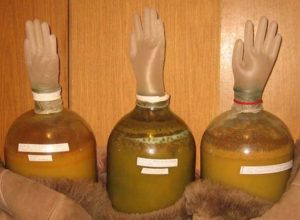
- When the fermentation is over, the cider is drained from the residue in the same way and again kept in a dark room, but already at a temperature from + 6 ° C to + 11 ° C for about 3-4 months.
- Then it is filtered again, bottled, corked and stored in the refrigerator.
- The strength of such a drink is already from 4 ° C to 8 ° C.
Another option for making apple cider using the combined recipe is shown in the video below.
How to make cider sparkling
At home, it's easy to make real carbonated apple cider. To do this, at the stage of completion of fermentation, after filtration, it is poured into absolutely clean and dry bottles (plastic or glass). At the bottom of each bottle, before pouring the cider there, pour 10 g of sugar (a teaspoon with a slide) per 1 liter of liquid.
The drink bottle should have 6-8 cm of free space at the top. The containers are hermetically closed with lids and placed for two weeks in a warm room without light.
Sugar causes repeated fermentation with the release of carbon dioxide. Therefore, the gas pressure should be checked daily to release excess gas. Otherwise, it may be difficult to save the bottle. After two weeks, bottles of carbonated apple cider are stored in a refrigerator or cellar.
How to drink and serve apple cider
Apple cider tastes best when chilled. There are two ways to serve this drink:
- It is initially cooled to a temperature of + 12 ° C to + 14 ° C. And from a height of at least 1 m, the bottle is poured into six glasses. Foam will form when a strong jet touches the glass. Since it fades quickly, the cider needs to be consumed fairly quickly.
- Otherwise, the cider does not require pre-cooling. And you just need to put ice in glasses and add a drink. In this case, you can drink it even in small sips.
There may be a sediment at the bottom, which does not have to be finished, but it indicates the natural origin of the product.

Cider goes well with fish or meat dishes, but it is ideal to serve it with cheese dishes and fresh fruit.
How is cider different from beer
In terms of calorie content, both products are approximately similar, but the cider contains no yeast, hops and barley. Yeast can be more harmful than beneficial, but barley and hops are sources of B vitamins and protein.
Beer lags behind in the amount of polyphenols - antioxidants from the plant world, as they are removed during the brewing process along with the cloudy sediment.
On the other hand, beer contains less carbohydrates than cider. Especially if the latter was prepared with added sugar.
Harm of apple cider and contraindications
Due to the alcohol content in cider, although in small quantities, the drink should not be consumed by pregnant women, lactating women and children, the harm may be more significant than the benefit.
People who have been diagnosed with pancreatitis, cholecystitis and diabetes should be wary of apple cider.
Due to the increased acidity of the product, it can be harmful for stomach diseases - gastritis and peptic ulcer.
Conclusion
Of course, both the benefits and harms of apple cider depend on how the drink was made. To be completely sure of its beneficial properties, it is better to cook it yourself.

